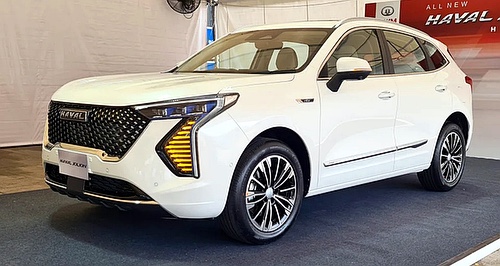Future models - Haval - Jolion - HybridJolion to become Australia’s most powerful hybrid small SUVHaval set to bolster small SUV range with 140kW petrol-electric Jolion18 Nov 2021 By MATT BROGAN HAVAL has revealed a new petrol-electric hybrid version of its popular Jolion small SUV. The Nissan Qashqai-sized hybrid model is tipped to join the local line-up of Great Wall Motors’s Haval sports utility sub-brand – along with the already confirmed H6 Hybrid – next year.
The punchy hybrid model, which is ostensibly the most powerful petrol-electric derivative in its class, was unveiled to local press at GWM’s new Rayong production facility in Thailand. It was revealed that the newcomer shares its powertrain with the larger Haval H6 Hybrid.
As such, it utilises a 1.5-litre four-cylinder turbo-petrol in combination with a single electric motor, but it’s detuned to provide combined system outputs of 140kW and 375Nm. It drives the Jolion’s front wheels via an in-house-developed seven-speed direct hybrid transmission.
The Thai spec sheet for the Jolion Hybrid reveals a combined-cycle fuel economy figure of 4.2 litres per 100km, which is about 3.9L/100km lower than its petrol-powered sibling.
By way of comparison, the Jolion Hybrid tops the maximum outputs offered by the Honda HR-V e:HEV (96kW/253Nm), Kia Niro Hybrid (100kW/395Nm), Subaru XV Hybrid (110kW/196Nm), Toyota C-HR Hybrid (112kW/190Nm), while undercutting its competitors on combined cycle fuel consumption by 1.2-, 0.2-, 2.3-, and 0.1L/100km respectively.
The petrol-electric Jolion features a remodelled front-end with LED headlights and vertical DRLs flanking a wider Star Matrix grille. It also gains 18-inch alloy wheels, but the inverted L-shaped tail-lights and the rest of the exterior is unchanged from the non-hybrid versions.
Inside, the Jolion Hybrid carries over the sophisticated, smooth lines of Haval’s minimalist dashboard and includes a 7.0-inch instrument cluster and 12.3-inch infotainment screen.
Apple CarPlay, Android Auto and Bluetooth connectivity are standard, as is a six-speaker audio system, dual-zone climate control, six-way-powered driver’s seat, a wireless phone charging pad, as well as the choice of four artificial leather upholstery options.
Safety systems are also like those found on purely petrol-engined Jolion derivatives, with six airbags, stability control, AEB, adaptive cruise control with Stop&Go function, blind-spot monitoring, rear collision and rear cross-traffic alert, plus a reverse parking assistant.
Pricing for the Haval Jolion Hybrid is yet to be announced in Thailand, but it’s understood that the vehicle will be priced between 800,000 and 1,000,000 baht (the equivalent of A$33,540 and A$41,925), which undercuts the Haval H6 by 45,000 baht (A$1,890).
Locally, the Haval Jolion – which replaced the H2 in the Chinese manufacturer’s line-up – is priced from $25,490 drive-away for the entry-grade Premium. The base version is topped by the mid-spec Lux ($27,990 drive-away) and the top-shelf Ultra ($30,990 drive-away).
To the end of October, GWM Haval registered 1977 H2s and 2843 Jolions to take a combined 4.6 per cent share of the segment – the same percentage as the seventh-place Honda HR-V (with 4812 local sales).
The Small SUV <$40k segment is currently topped by the MG ZS (with 14,867 units sold), Mitsubishi ASX (12,087), Mazda CX-30 (11,329) and Hyundai Kona (11,157).  Read more14th of May 2021  Haval prices full-time Jolion range from $25,490 d/aFull-time Haval Jolion range touches down just a month after Launch EditionsAll future models Alfa Romeo Alfa Romeo Abarth Abarth Audi Audi Aston Martin Aston Martin BMW BMW Bentley Bentley Chrysler Chrysler Chevrolet Chevrolet Dodge Dodge Citroen Citroen Ferrari Ferrari DS DS Ford Ford Fiat Fiat FPV FPV Foton Foton Haval Haval Great Wall Great Wall Honda Honda Holden Holden Hyundai Hyundai HSV HSV Isuzu Isuzu Infiniti Infiniti Jeep Jeep Jaguar Jaguar Lamborghini Lamborghini Kia Kia Lexus Lexus Land Rover Land Rover Mazda Mazda Maserati Maserati Mercedes-Benz Mercedes-Benz McLaren McLaren Mini Mini Nissan Nissan Mitsubishi Mitsubishi Peugeot Peugeot Opel Opel Proton Proton Porsche Porsche Renault Renault Ram Ram Saab Saab Rolls-Royce Rolls-Royce Smart Smart Skoda Skoda Subaru Subaru SsangYong SsangYong Tesla Tesla Suzuki Suzuki Toyota Toyota Volvo VolvoMotor industry news |
Click to shareHaval modelsResearch Haval All future models Alfa Romeo Alfa Romeo Abarth Abarth Audi Audi Aston Martin Aston Martin BMW BMW Bentley Bentley Chrysler Chrysler Chevrolet Chevrolet Dodge Dodge Citroen Citroen Ferrari Ferrari DS DS Ford Ford Fiat Fiat FPV FPV Foton Foton Haval Haval Great Wall Great Wall Honda Honda Holden Holden Hyundai Hyundai HSV HSV Isuzu Isuzu Infiniti Infiniti Jeep Jeep Jaguar Jaguar Lamborghini Lamborghini Kia Kia Lexus Lexus Land Rover Land Rover Mazda Mazda Maserati Maserati Mercedes-Benz Mercedes-Benz McLaren McLaren Mini Mini Nissan Nissan Mitsubishi Mitsubishi Peugeot Peugeot Opel Opel Proton Proton Porsche Porsche Renault Renault Ram Ram Saab Saab Rolls-Royce Rolls-Royce Smart Smart Skoda Skoda Subaru Subaru SsangYong SsangYong Tesla Tesla Suzuki Suzuki Toyota Toyota Volvo VolvoMotor industry news |





















Facebook Twitter Instagram